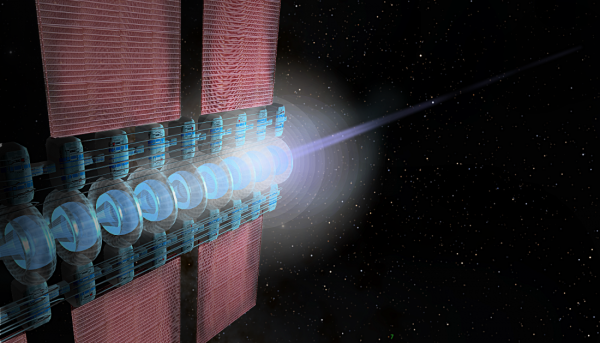BY LETTER
Lightways, The
Technology > Application > Communications
Galactography > Other Major Polities, Empires, and Meta-Empires > Deeper Covenant
Galactography > Other Major Polities, Empires, and Meta-Empires > Deeper Covenant
Interstellar Laser Communication Network | |
 Image from Steve Bowers | |
| An interstellar communication laser from the First Federation Era | |
Snapshot: The Lightways
A question manifested in my mind, crystal clear; "What is your destination?"
I hung disembodied in a cloud. My implants had shut off all sensation in my body. A good thing too as dissasembler foam was being pushed into my orifices and razor sharp threads were delicately flensing my skin. I would be conscious for a few moments longer as the engenerator chamber uploaded me. Before then it wanted to know exactly what I wanted it to do with me.
"Random destination" I answered with my inner voice.
If the engenerator was confused by that request it didn't show it. It was scanning my brain so presumably it noted no psychological disorders influencing the decision. Without a pause it asked its next question, "What are your arrival preferences?" All travelers on the lightway had some requirements. The journeys themselves lasted a subjective instant as the photons encoding the traveler were beamed between stations. But the speed of light is a crawl. Conditions on arrival might not be the same as advertised when the journey began. Preferences included such information as how much local knowledge to graft into short term memory, what mental and bodily modifications would be acceptable in order to function in local society, what conditions would the traveler like to awaken in etcetera.
"I'd prefer no knowledge of my location and to be awoken in a random place, in any locally appropriate form" I really had become so bored over the millennia of my life that this is what I was resorting to.
"Itinerary confirmed. Standby for transit"
- Memories of Lighters
Travel by Laser
Alongside the Wormhole Nexus and the Beamrider Network, the Lightways stand as one of the great interstellar transportation networks of the Terragen Sphere. They are the fastest and most efficient way of travelling between stars, both within the nexus and beyond it.In the broadest sense, the Lightways are the totality of laser connections across interstellar distances in the Terragen Sphere. When one speaks of the Lightways' physical architecture, one is referring to the great laser transmitters and receivers found in almost every inhabited system — and, of course, the streams of photons between them. Inside the Sephirotics and other archai-controlled empires, the Lightways are part of the Known Net and the God Web, routing travelers seamlessly through both traversable and comm-gauge wormholes; elsewhere, they are composed of thousands of independent but interlinked networks across the Hinterregions and Outer Volumes.
In common parlance, however, one usually refers to the Lightways as a transportation system, where mindstates are transmitted by laser. In this sense, they are a cultural concept as much as physical infrastructure: a sophont looks up information over the Known Net, but travels by the Lightways.
As a transport network, the Lightways are more extensive than the Wormhole Nexus and even the Beamrider network, with 96% of stars in the Civilised Galaxy having some sort of connection to the system.
The physical infrastructure consists of laser transceivers, Stellar Lensing Receivers at a star's gravitational focus, and an associated set of computronium and habitats to house travellers (traditionally called Inns). A mindstate can be relayed from system to system for hundreds or thousands of lightyears. In principle one could travel from one end of the Terragen Sphere to the other through the Lightways, without ever needing to pass through a wormhole (though few travellers choose this option).
In the Current Era, the Lightways have a combined length of 10 billion lightyears, with an estimated 4 quadrillion sophonts in transit at any given time.
History
The Lightways emerged organically alongside interstellar civilisation. The early ahuman AI were almost certainly the first to use lasers to communicate and transmit mindstates across interstellar distances, and the First Federation used the technology extensively. So too did the Megacorps, and all interstellar polities up to the creation of the Nexus.At first, the Lightways were limited to aioids, virtuals and uploads. Vecs, with brains that make a mindstate relatively easy to download, became the next travellers in the Early Federation. With the development of Engenerator technology, the Lightways were finally open to bionts who wished to be embodied upon arrival.
At this stage, the Lightways were less a cohesive system than a patchwork of laser emitters and receivers, using a wide variety of protocols, standards, and wavelengths.
There were dozens of attempts to standardise the system, but the first attempt at Terragen-wide unification came with the Second Federation. Across the Inner Sphere, infrastructure was updated. The SecFed Ontology specified universal protocols, so a signal could be relayed from one empire, through another, to a third without ever changing formats.
Though the standardised Lightways rose with the Second Federation, they survived its downfall. Many wormholes were closed to modosophonts and transapients, or even destroyed, during the Version War. During this period, the Lightways became an essential element of interstellar traffic and communication for lower toposophics. Some have even claimed the Version War was their heyday. And more than one wordplay-inclined historian has suggested that it was the Lightways that prevented a true dark age.
During this period, a wormhole posed a great threat to its host system — if it were destroyed, or used by an attacking fleet seeking to annexe the system. But, of course, the Lightways themselves were not free of danger. At the height of the war, the Solar Dominion colony of Urizen was destroyed by Cyberian virchwars that arrived disguised as allies and then began releasing waves of viruses. Similar attacks damaged dozens of other systems.
In recognition of these attacks, there was a move towards Lightway neutrality during the ComEmp. "Innkeeper" AIs, loyal only to the Lightways themselves, were created to administer the relay stations. They checked incoming transmissions scrupulously for possible infection vectors. Additional measures for security and safety were added gradually. With this move, the Lightways became a semi-independent entity, and almost a minor polity unto themselves. Some 65% of Lightway stations in the Terragen Sphere now use the Innkeeper system.
 Image from Steve Bowers | |
| A Lightways tranceiver on Tethys, a moon of Saturn, using phased array technology | |
The Lightways Today
With modern technology, the Lightways are one of the safest and most secure ways to travel interstellar distances, and they are an essential part of transport infrastructure outside of the Nexus.Each star is linked to its nearest neighbours (usually those within 80 light years). Long distance travel usually consists of a series of stages between one star and the next, the mindstate being relayed at each star. The subjective travel time, of course, is zero — but many travellers request to be brought online every few stages to keep up to date with the news. Indeed it is standard practice for travellers to include a list of preferences in their transmission detailing the environment of their engeneration, the extent to which they consent to local adaptations and conditions for aborting the journey (leading to instantiation at the most recent inn, or where-ever preferences state). Depending on local customs these preferences may be meticulously followed, completely ignored or anywhere in between.
All transmissions are encrypted to minimise the risk of the signal being intercepted and the traveller being captured by eavesdroppers. Each lightway relay broadcasts a public key which can be used by transmitting stations to ensure their passengers can only be decrypted by the intended recipient. A planned transmission through a series of relays can be locked with the public key of all of them, further securing the journey. For maximum security many lightway stations generate entangled photons, one of each pair they stream to a neighbour along with classical information relating to their measurements. The receiving station can verify the integrity of the transmission using the classical data (detecting any interference from evesdroppers) and use it to generate a one-time-pad. This process allows each station to build up a store of quantum encryption one-time-pads for each of its neighbours. Maximally secure though it is these stores can be depleted in rare cases of high traffic, with resupply taking years as new entangled photons cross space. Each mindstate transmitted is sent in triplicate to minimise the risk of loss or corruption. At every stage, the transmitting Inn keeps a backup until it gets a positive signal from the receiving Inn. (And should a traveller ask for it, many Inns will keep a backup after that in case of loss further down the line.)
As one moves outwards through the Terragen Bubble, wormhole links become more scarce. In the Inner Sphere, the majority of systems are connected to the Nexus; in the Outer Volumes, less than 1% of systems are connected. It is here that the Lightways see their greatest use.
Physical Architecture
The largest part of the Lightways' physical architecture are the transceivers. A transceiver is a spherical membrane hundreds or sometimes thousands of kilometres across, to give as large an effective aperture as possible. An interior of warm hydrogen gas keeps the membrane taut. Though it is very large, the transceiver usually has a low albedo.Stellar Lensing Receivers, or SLRs, may be placed at the star's gravitational focus, several hundred AU away. By using gravitational lensing, the maximum distance and bitrates of Lightway communications are vastly increased at the cost of a few extra days of travel time. There needs to be one SLR, located on the far side of the star, for each incoming link using gravitational lensing. The SLRs are equipped with coronographs to minimise coronal noise from the star. Structurally, they are thin discs between ten and a hundred kilometres across, rotating to maintain their shape. The SLRs relay their signals to the main transceiver sphere using in-system lasers.
 Image from Steve Bowers | |
| A diagram showing the amplification of an interstellar signal using the gravity of the local star. Left is the Einstein Ring formed by a signal from a distant location around the local star; right is the same view with a coronograph obscuring the star. Amplification by a factor of a million can be acheived using this technique. | |
Transmitter lasers are usually built directly into the surface of the transceiver membrane. Either a single one is aimed at each adjacent system, or the entire transceiver sphere is used as a phased array laser. Depending on necessary bandwidth, the lasers will transmit in frequencies anywhere between ultraviolet and gamma radiation.
If there are Known Net nodes in the system, the transceiver will relay updates to them with a second set of local lasers.
Finally, the Inn is a layer of computronium inside the transceiver sphere, usually no more than a metre thick. It contains the Innkeeper AI, relays interstellar communications to the rest of the system, and holds travellers before they are transmitted onwards. The Inn also hosts a number of virch worlds. Here, inbound and outbound travellers mingle, and inbound travellers update themselves on the current state of the system. Many embodied travellers now entrust their upload and engeneration with the Innkeepers, so an Inn will usually also have one or more small habitats inside the sphere, accessed by portals on the surface.
Innkeeper AIs are present in some 65% of Lightway stations. They are usually associated with the Sephirotics, but never align with any empire in particular. They maintain the neutrality of the Lightway station, ensure proper encryption and decryption of travellers and forbid unauthorised mindstate copying.
Innkeepers are S1, or more rarely S2, entities, but their mental processes have been designed by higher toposophics to be resistant to subversion even by an S3. In more developed systems, the Innkeeper may be a subroutine of the local archailect.
Outside the Innkeeper system — usually in regions in the Outer Volumes — Lightway travel is sometimes considered relatively more risky. Different encryption standards are used, and nonconsensual copying is a common fear. And indeed it does happen on occasion — but for the most part, the Lightways in the Outer Volumes are safe, with an average hazard rating of 2.5.
Cultural Factors
An aversion to travelling the Lightways is sometimes referred to as Limnophobia. This is most common among bionts, where it is usually associated with aversion to uploading or engeneration. But it is not unknown among aioids: One may fear signal corruption enroute, being nonconsensually copied and decrypted, or simply being deactivated for long periods.A standard journey through the Lightways takes zero subjective time and, when routed through the Nexus, a far shorter amount of external time than any other method. The majority of the system's users travel this way, but not all.
By request, one can be reawakened every few Inns, where hey may spend a few hours — or a few years — catching up on the news, and conversing with er fellow travellers. Besides the pleasure of doing so, this allows one to better keep abreast of developments in the rest of the Terragen Sphere
Taking the notion of the scenic route to an extreme, some sophonts simply travel for the sake of travelling, rarely or never using the Nexus. Indeed, this can be a convenient form of "interval stasis" (where a sophont, perhaps bored with er current existence, chooses to go into a stasis and be reawakened at regular intervals). For others, "flowing through the void as a ripple of electromagnetism" is a spiritual practice in of itself.
Virchships are a common phenomenon. Consisting of a group of sophonts and virchworlds travelling together, they wander across the Lightways towards whatever systems take their interest.
The Inns have also attracted a number of permanent residents, occupying their virches to interact with the travellers. With the residents and travellers together, the Inns across the Lightways often have a culture of their own, slightly apart from their all their host systems: Exploratory and novaphilic, with sophonts always coming and going; and yet at the same time, laid back and relaxed, a culture in which travelling is valuable for its own sake rather than simply as a means of getting somewhere. This, together with the scrupulous neutrality of the Innkeeper AIs has led some commentators to classify the Lightways as a distributed polity separate from its host systems — however, it is by no means a civilisation of comparable power to the Deeper Covenant, for instance.
Finally, a traveller may be transmitted outwards and leave the known Lightways entirely. If encrypted, such a Mindstate will almost certainty never be awakened again. For some, this is enough — a form of immortality, or at least a chance of outliving (in some sense) Terragen civilisation, even if one isn't in a position to appreciate it. On the other hand, some explorers travel unencrypted, towards the various HEECs or the Leviathan.
Related Articles
Appears in Topics
Development Notes
Text by Liam Jones
Initially published on 12 July 2017.
Initially published on 12 July 2017.






